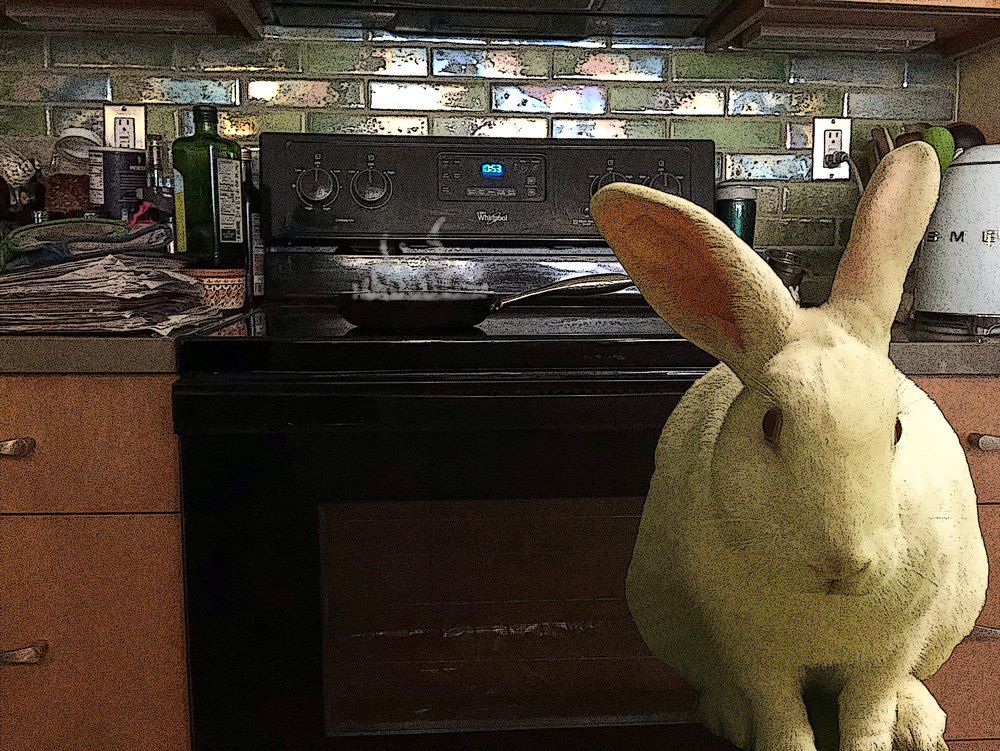
Does your long-eared lad or lass have a nemesis like The Sizzle? Well, there might be a way to help them.
It’s Training to the Rescue!
There’s two things you can do with training. One is to teach bunny to do something new. The other one is to change how he feels about something, and as a result, what he does in response to it. Whether it’s running away, freezing, or attacking, “bad behavior” is all motivated by fear. In many cases, careful and patient training can banish that fear.
The highly-effective technique that trainers use for this is called “Desensitization and Counter-Conditioning.” It’s not complicated but it is important to make sure you do it right. And if you’re interested in trying it, the first thing I think you should do is let somebody smarter than me explain it.
Fortunately I know of just such a person! This article by Zazie Todd is pretty perfect. She wrote it in reference to dogs, but if you just replace “dog” with “rabbit” throughout, it translates pretty well. So take a few minutes to read it – maybe even print it out for reference – and then come on back. I’ll wait here.
One thing that doesn’t translate directly from Zazie’s article is that bunnies show fear a little differently than dogs. How to recognize if your rabbit is afraid? Here’s a table of things to look for that indicate the level of fear, or stress, your furry friend may be experiencing.
| Rabbit State | Behavior |
|---|---|
| Relaxed, normal | Sleeping, frolicking, playing or casually exploring; will take a treat if offered |
| Slightly stressed | Staying still but not sleeping; very attentive to sounds and smells; eyes may be wider than normal, may take a treat but lacks typical enthusiasm, maybe snatches it and moves away immediately |
| Stressed | Breathing faster than normal; face is tensed; won’t take treats (“Tensed” is tough to define, but if you are very familiar with your rabbit you will start to notice how their face looks when they are relaxed, vs. when something is upsetting them.) |
| Very Stressed | Body very flat, ears back, motionless, eyes wide, or trying desperately to escape, or growling, lunging, or attacking |
| Information thanks to G Bradbury, Behavioural Problems in Rabbits: A Clinical Approach, 5M Publishing Ltd. 2018, p.84 Diagram 3.7 | |
Desensitization and Counter-Conditioning for Rabbits
Now, let’s review the basics Zazie explained, but with rabbits in mind. Here’s the basic process.
FIRST present the scary thing (in Finny’s case, the sound of the sizzle) at a very low level (far away or muffled).
IMMEDIATELY AFTER the scary thing appears, give a high value treat.
Note that the order is really key here. You want the sound of the sizzle to become a signal that a great snack is coming, not the other way around.
In addition to making sure you get the order right, you have to keep the level of the stimulus low enough not to upset your rabbit. If he won’t take a treat, he’s stressed. If he tenses up when the noise starts, he’s stressed. In that case you have to make the noise even softer. A great way to do this is to make a recording of the noise on your phone and play it at a really low volume.
Why this is important:
- It enables learning. Ever notice that when you get stressed or fearful, you don’t think as clearly? Well, if you can’t think, you can’t learn. We are trying to teach him that the sizzle is OK. To learn that, he has to remain calm.
- If he’s not calm the whole experience is just unpleasant. You want it to be fun.
- Stress could also result in that great treat becoming less palatable, as a result of becoming associated with bad stuff.
- And finally, as Zazie mentioned, if you go too fast you could accidentally do the reverse of your intention and sensitize him to the scary thing, making the situation worse instead of better.
I will confess that I have personally screwed this up in the past. I was trying to reduce a chihuahua’s fear of traffic noises. I didn’t see the early warning signs of stress as I increased the volume of the sound. Instead of becoming comfortable with cars, my student became afraid of his previously favorite dog food. Boy, did I feel like a jerk. So when in doubt, take a conservative approach:
- keep the scary thing more muted than you think you have to,
- increase intensity of exposure slower than you think you need to,
- use a very high value treat.
You’ll probably want to practice this in short bursts at first. In other words, the scary thing should go away quickly. As you start increasing the duration, make sure you are also feeding treats throughout the experience. As Jean Donaldson Founder of the Academy for Dog Trainers, described it, the scary thing brings the “open treat bar” – all you can eat. Without the scary thing, the bar is closed.
After you repeat this a number of times you may notice that the muffled version of the scary noise makes your bunny actually perk up, and look for the coming treat. When this happens, you’ll know it’s working. From there you can slowly and very gradually increase the duration and the volume/proximity of the Evil Entity, making sure he’s still relaxed and anticipating the treat each time.
Finnegan and The Sizzle
We procrastinated on helping Finnegan with the sizzle for a long time. We had lots of excuses for deferring it. First and foremost among them: Our open kitchen and living room are connected in one big space, so Finnegan lives in the same room as the stove. For this intervention to be effective, we’d have to refrain from cooking anything on the stovetop until the training was complete. After all, most things you cook on the stove do sizzle. Luckily, baking, boiling and microwaving were still OK with Finnegan. So Step One was to make a meal plan for a few weeks that would be sizzle-free.
On Christmas morning, I whipped up a batch of pancake batter and fired up Voice Memos on my iPhone to get a recording as they sizzled away. Then I took the phone into another room to adjust it to a volume that I felt confident would be acceptable to Finnegan’s radar-dish ears. Finally, I broke a few dried cranberries into tiny little bits for training and we began.
I looked for at least two time each day to conduct the training. I would play the recording (about 45 seconds long) and deliver a steady stream of cranberry bits until the noise stopped. Moraea usually stuck her nose in and reaped the same reward as Finny. It wasn’t necessary to get her involved, it was just easier than trying to separate them and there was no harm in it. Here’s a session during the first week. The level of sound is still pretty low so you may have to turn up your volume to detect when the sizzle starts.
Once we worked our way gradually up to a normal sizzle volume, I switched from using the phone to using my computer speaker to get a more rounded, less tinny sound quality.
After about two weeks of daily training, I got clear confirmation that this effort was working: I accidentally started up The Sizzle before positioning myself near Finnegan. He immediately hopped over to me for his treats! Here’s a video from a few days later. When I trigger The Sizzle, both FInnegan and Moraea are on the other side of the room. Watch what happens.
A Happy Ending
On a Sunday morning about three weeks after I started training, I gathered a handful of tasty treats as my husband started cooking his omelette. When the sizzling began, I started handing out the goods. Success! No sign of fear or stress was apparent, and Finnegan quickly settled into a nap afterwards. We’ll continue to offer treats every time we cook on the stove, for another week or two just to ensure the training is solid. At last, we can sauté guilt-free! Here’s some video of the magical moment.
 The Fluffy Tail of This Blog Post
The Fluffy Tail of This Blog Post
Desensitization and counter conditioning is a powerful technique to master. It takes some patience and very close observation to ensure you get the timing right and don’t rush it. But if you take it slowly, you can make a huge difference in a fearful bunny’s life.